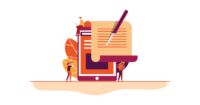The design community has gone through a major rebrand in recent years. It wasn’t long ago that most companies seem like they had logos designed by someone’s 17-year-old who had a copy of Photoshop CS3. Now, even the smallest storefronts are reaching out to agencies and dropping major money on slickly designed websites. There’s been a shift in focus. Design used to be a fringe service concerned with clip-art laden fliers. It is now seen as an essential craft worth investing budget into.
I appreciate most of the ways the industry has changed, but I’m concerned with the sense of self-importance the rebrand seems to nurture. More and more designers have started presenting themselves as curators of cool rather than grateful craftsmen.
Designers like to be disruptive
Being a creative industry, graphic design naturally attracts creative people. Creatives are valuable assets, because they see solutions where others do not. It’s for that very reason creatives don’t like rules. This resistance to establishment can infuse a designer with the attitude that the most important aspect of any design is originality. I’ve seen this most often displayed through the use of disruptive language.
A designer focused on disruption usually says something like: “I like to throw out the rules and take a fresh look at every design. I’m the kind of designer who thinks outside the box. I’m looking for an environment where I can do something really creative and not just follow style guides all day.”
Disruptive language is usually adopted to position a designer as an expert, while reinforcing the idea that the brand needs their help. Many designers will criticize a client’s brand to their face and draw attention to the ways a design is failing. I wonder if they realize how insulting they can be. More importantly, I wonder if they notice the effect this kind of language has on the client.
I love your brand for all the ways I hate it
It’s true that disruptive language can inspire a client into action, but it tends to have a negative effect on the relationship. People have worked hard on their brands. They don’t want to hand their brand over to someone who doesn’t respect it.
Rather than welcoming the new design ideas, clients brace and resist them. This leads the designers to resent the client, work in the dark and distance themselves during the process. Ironically, the designer takes these opportunities to complain about client work and how inflexible brands are.
A better way by design
Design, as a practice, is far more complimentary and enabling than disruptive. This is especially true of communication design, which is the discipline of finding creative solutions to communication problems. Communication is built on commonality. Mistaking originality for creativity leaves a designer resistant to the very systems of communication they need to do their job.
Effective design communicates with the audience
Clients are far more likely to work with a designer who can demonstrate they have vision for their brand. Telling them the potential you see in their brand is far more valuable than pointing out how ugly their logo is. They didn’t come to you to hear how they’re failing. They came to hear how they can succeed.
Be creative, not disruptive
The great thing about creativity is that it can be applied to anything. The idea that the only things worth creating are completely original is both ignorant and dismissive. The challenge of design isn’t to create something new. It’s to create the right solution to a problem.
Related resources:
More Content
6 B2B Graphic Design Trends to Watch for in 2020
Design plays an integral role in B2B marketing, and as we’ve discussed in the past, graphic design in the B2B sphere differs in some significant ways from B2C. B2B companies and
Content Audits for Better Content Marketing
The word “audit” strikes fear in many. (Financial or tax audits are probably the first to come to mind.) To others, conducting an audit may sound dull or tedious. We
The Copywriter’s Grab Bag: Part 3
Some trilogies get better with each installment (see: Linklater’s “Before” triptych). Some trend toward the terrible (ugh, both “Mockingjay” movies and “The Matrix Revolutions”). And others, while not technically trilogies,




Leave A Comment